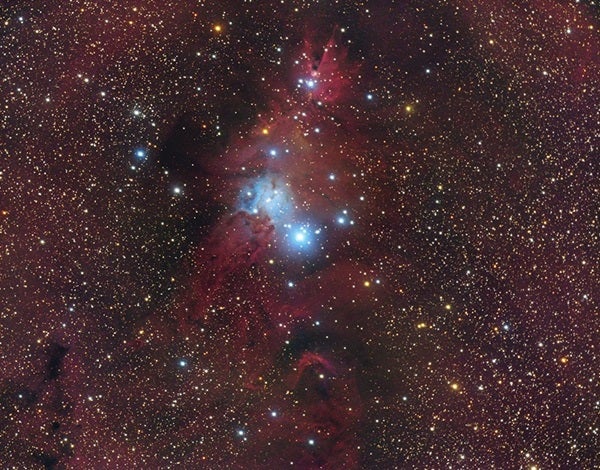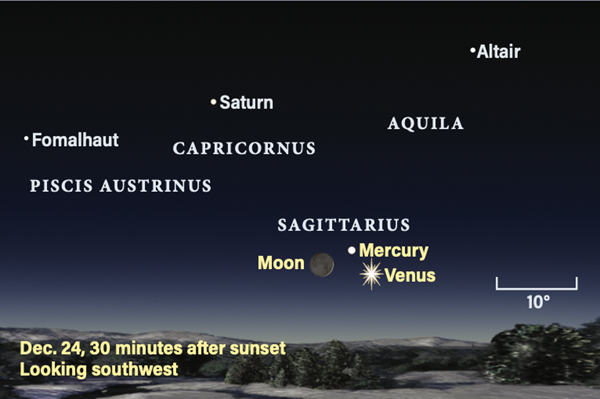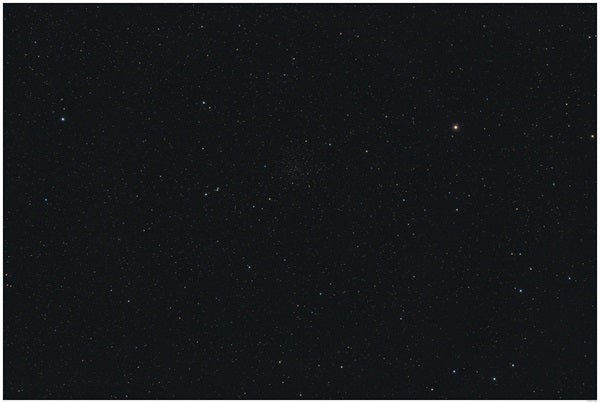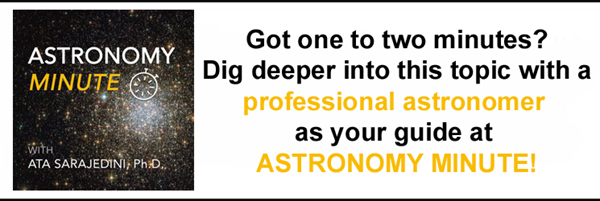Friday, December 23
Let’s start the week at the top of the Messier catalog: M1, more famously known as the Crab Nebula, is rising in Taurus at sunset. Wait for full dark, then swing your scope just over 1° northwest of 3rd-magnitude Alheka, which marks the tip of the Bull’s easternmost horn.
In such a dark sky, even a 3-inch scope should net the Crab for you. (Though if you can manage it, larger telescopes will make this object easier to find by gathering more of its light.) Shining at magnitude 8, the Crab stretches about 6′ by 4′ oriented northwest to southeast and has a relatively high surface brightness. Despite the amazingly detailed pictures you may be used to seeing, though, don’t expect too much from your telescope. You’ll likely see an oval-shaped smudge of light, like a faint fingerprint — but don’t let that disappoint you. This seemingly innocuous glow is the guts of a massive star whose supernova was seen in the sky in the year A.D. 1054. That supernova was so bright that it outshone Venus and was visible during the day for nearly a month. Today, nestled in the center of the mess is the Crab pulsar, a rapidly spinning neutron star born from the crushed core of a once-brightly shining sun.
Sunrise: 7:20 A.M.
Sunset: 4:39 P.M.
Moonrise: 7:53 A.M.
Moonset: 4:49 P.M.
Moon Phase: New
*Times for sunrise, sunset, moonrise, and moonset are given in local time from 40° N 90° W. The Moon’s illumination is given at 12 P.M. local time from the same location.
Saturday, December 24
The Moon reaches perigee, the closest point to Earth in its orbit, at 3:27 A.M. EST. At that time, our satellite will be 222,619 miles (358,271 kilometers) away.
Although now just a thin crescent, the Moon will take part this evening in a beautiful tableau. After passing 3° south of Venus at 6 A.M. EST and 4° south of Mercury at 4 P.M. EST, the Moon stands east of Mercury and Venus in the southwestern sky some 30 minutes after sunset. Mercury, at magnitude –0.5, is to the Moon’s upper right, while Venus (magnitude –3.9) is to our satellite’s lower right; together the three form a triangle against the fading twilight.
Through a telescope, Mercury’s disk appears 7″ across and is nearly half (49 percent) lit. Venus, by contrast, is almost fully lit (97%) and stretches 10″ in width. Train your scope along the delicate lit edge of the Moon to enjoy the play of light and shadow along the rugged landscape slowly revealed by the terminator separating night and day.
The trio will set around 6 P.M. local time.
Sunrise: 7:20 A.M.
Sunset: 4:39 P.M.
Moonrise: 8:56 A.M.
Moonset: 6:03 P.M.
Moon Phase: Waxing crescent (3%)
Sunday, December 25
Tonight is the perfect night to step outside and enjoy the Christmas Tree Cluster shining in the sky. This conifer-shaped grouping of stars lies within NGC 2264, which encompasses both the cluster and the Cone Nebula. You’ll find it in northwestern Monoceros the Unicorn, near the feet of Gemini the Twins. The region rises in the east around 6 P.M. local time but if possible, give it an hour or two to climb above the turbulent air at the horizon before searching out our quarry.
NGC 2264 sits just over 3° south-southwest of magnitude 3.4 Alzirr (Xi [ξ] Geminornum). The Christmas Tree Cluster shines at magnitude 3.9, making it a nice naked-eye target in dark skies. You’ll likely see it as a fuzzy glow to the lower right of Alzirr; binoculars or a telescope will bring out some 10 or 15 stars, which through a telescope will form up into the rough shape of a triangular Christmas tree, including the trunk. Note that the tree may appear upside-down through your optics, with the top of the tree just meeting the trip of the Cone Nebula. Magnitude 4.6 S Monocerotis is at the base of the trunk, while 7th-magnitude HD 47887 marks the sparkling “star” at the top of the tree.
Sunrise: 7:20 A.M.
Sunset: 4:40 P.M.
Moonrise: 9:48 A.M.
Moonset: 7:22 P.M.
Moon Phase: Waxing crescent (8%)
Monday, December 26
The Moon passes 4° south of Saturn at 11 A.M. EST. You can spot the pair, located in Capricornus, above the southwestern horizon after dark. Saturn, now magnitude 0.8, is a gorgeous telescope target with rings stretching 36″ across. The Moon, which sits to the planet’s left (southeast) in the evening, is now 18 percent lit, showing off more of its eastern limb (which appears west in the sky). Readily visible is the large, round Sea of Crises, whose dark, lava-flooded floor is now fully illuminated by the Sun. Third-magnitude Deneb Algedi sits between the Moon and Saturn; the planet will appear brighter than the star, helping you identify them correctly.
You can easily catch a glimpse of the solar system’s other gas giant, Jupiter, by simply looking to the pair’s upper left (east). There, magnitude –2.4 Jupiter hangs in Pisces, sitting left (southeast) of the Circlet asterism. Through a telescope, the gas giant spans an impressive 40″. Its four Galilean moons are on ready display, with Europa (farthest) and Io to the west, and Ganymede (closest) and Callisto to the east. All four will remain visible all evening, as no occultations or transits are taking place right now.
Sunrise: 7:21 A.M.
Sunset: 4:41 P.M.
Moonrise: 10:28 A.M.
Moonset: 8:41 P.M.
Moon Phase: Waxing crescent (16%)
Tuesday, December 27
Comet C/2020 V2 (ZTF) continues its trek near the North Celestial Pole, now 5° from Polaris and less than 4° from the open cluster NGC 188 this evening. The 10th-magnitude comet sits southeast of the cluster; both are easy to pick up in an 8-inch scope. Visually, the comet will likely appear as a whitish ball of light, but imagers may pick up some green in its coma.
If you’re looking for a bit more wow factor, you won’t have to look far: Skim over to Ursa Major and you can enjoy M81 and M82, a pair of galaxies just over 0.5° apart near Theta (θ) Ursae Majoris. (For a closer signpost, look 2° east of 24 Ursae Majoris.) Through binoculars, a finder scope, or a low-power telescope, you’ll likely grab both galaxies at once, offering the perfect opportunity to compare their shapes. Both are spirals, but M81 appears distinctly oval, while M82 is much longer and thinner. The latter is often called the Cigar Galaxy and appears this way because we are viewing the galaxy edge-on, looking through the plane. Zoom in with higher power to enjoy each galaxy on its own with a bit more detail.
That the two galaxies appear close on the sky is not simply a chance alignment — they are in fact close to each other in space as well. The two came closest some 300 million years ago, when gravitational interactions triggered star formation in both galaxies and began funneling material toward the centers to feed their supermassive black holes.
Sunrise: 7:21 A.M.
Sunset: 4:41 P.M.
Moonrise: 11:00 A.M.
Moonset: 9:56 P.M.
Moon Phase: Waxing crescent (25%)
Wednesday, December 28
The Moon passes 3° south of Neptune at 3 P.M. EST. Visible in the south after dark through binoculars, you’ll find the solar system’s most distant planet in far northeastern Aquarius, near that constellation’s border with Pisces, where Jupiter resides.
The Moon is now 3.2° southeast of the ice giant, whose small, 2″-wide disk shines at magnitude 7.9. You’ll find it between two 7th-magnitude field stars, on the eastern leg of a small triangle they form with a third 7th-magnitude star to the northwest. Bright Jupiter, an easy naked-eye object, is some 8° northeast of these stars.
Mercury stands stationary at 10 P.M. EST. Earlier in the evening, about 30 minutes after sunset, you can spot it in the southwest, now 1.5° to the upper right (north-northeast) of Venus. This is the closest the two planets will appear — after today, Mercury will track west of Venus and they’ll stand 4° apart by the end of the month. Mercury is also quickly fading. Tonight it is magnitude 0.05 and it will dim to magnitude 1.3 by New Year’s Eve.
Sunrise: 7:21 A.M.
Sunset: 4:42 P.M.
Moonrise: 11:28 A.M.
Moonset: 11:08 P.M.
Moon Phase: Waxing crescent (36%)
Thursday, December 29
Mercury passes 1.4° north of Venus at 4 A.M. EST, two hours before the Moon passes 2° south of Jupiter at 6 A.M. EST.
After sunset, First Quarter Moon occurs at 8:21 P.M. EST, with our satellite now some 6° east of Jupiter. Train a telescope on the bright planet early in the evening and you’ll spot one bright moon — Europa — to the west and three satellites — from nearest to farthest, Ganymede, Io, and Callisto — to the east.
Keep an eye on Ganymede, which closes in on Jupiter’s eastern limb and begins a transit across the gas giant’s face at 10:11 P.M. EST. It takes about three hours to cross as Jupiter sets for the eastern half of the U.S., though observers in the western portion of the country will catch the whole thing. All three of Ganymede’s fellow moons remain visible throughout the event.
Sunrise: 7:22 A.M.
Sunset: 4:43 P.M.
Moonrise: 11:52 A.M.
Moonset: —
Moon Phase: Waxing crescent (47%)
Friday, December 30
Although it’s now past opposition, Mars is still worth observing. It’s also an easy target, some 35° high in the east an hour after sunset. Tracking across the stars of Taurus, Mars now sits nearly directly above Aldebaran, just over 8° to the star’s upper left (north).
Through a telescope, the magnitude –1.3 Red Planet is 15″ across, already 2″ smaller than it appeared at opposition earlier this month. Later in the evening, in the hours around midnight in the midwestern U.S., imagers can catch Solis Lacus, Valles Marineris, and Sinus Meridiani on the Earth-facing disk. Look also for the white polar cap in the planet’s north, which has been steadily appearing as the darker north polar hood, a zone of clouds above the pole, recedes as the region transitions from winter to spring.
With the naked eye, the ruddy planet still makes a nice pairing with the nearby red giants Aldebaran and Betelgeuse. Look also for Castor and Pollux to the east, which mark the heads of Gemini the Twins. Slightly brighter Pollux may appear to the sharp-eyed as yellow- or golden-hued, while Castor will look blue-white. Try taking a quick snap on your smartphone to see whether it can pick up the color differences between these two bright stars!
Sunrise: 7:22 A.M.
Sunset: 4:44 P.M.
Moonrise: 12:15 P.M.
Moonset: 12:16 A.M.
Moon Phase: Waxing gibbous (57%)













